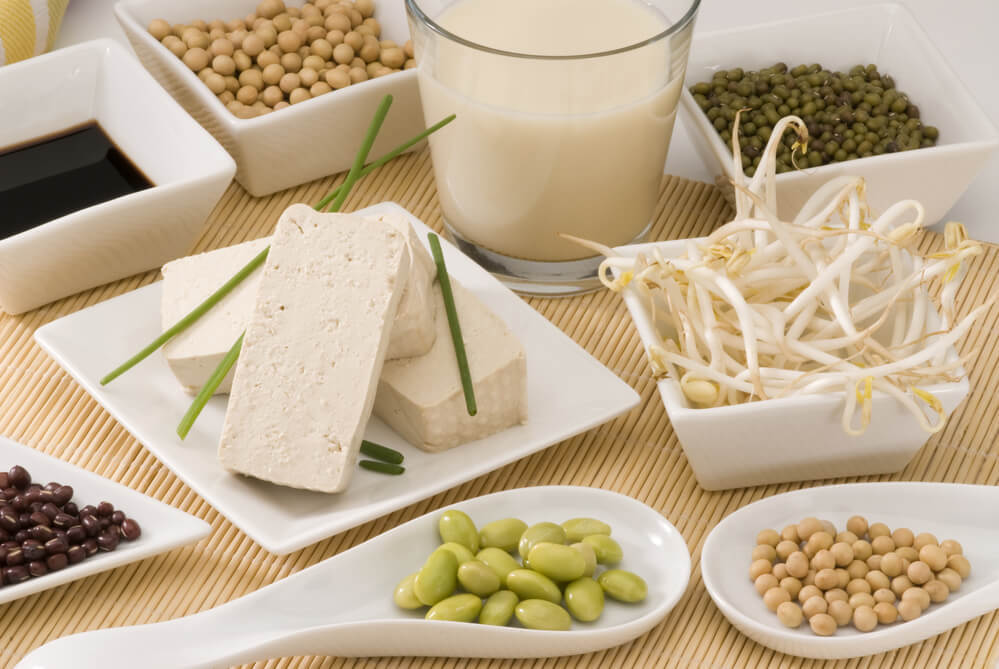
Introduction
What you might not realise is that your breakfast – regardless of what you ate – may actually contain soy. Soy and its derivatives are found in many varied foods including breakfast cereals, packaged breads and crackers, and cheese spreads. So even if you didn’t eat tofu and brown rice for brekkie today, you may have actually consumed some soy and didn’t even know it. A recent Australian survey indicated that between 1 in 4-5 people consume soy products. I actually think this number is inaccurate, as most people don’t realise that they are actually consuming soy.
Soy products are generally surrounded in controversy and confusion. Some of the information indicates that they are great sources of vegetarian protein and associated their benefits with longevity in Asian (especially Japanese) cultures. Other information negatively associates it with poor thyroid health, lowered fertility, negative effects to cancer risk and others. Let’s have a look at this intriguing food in more detail and try to dispel some of the myths.
Soybeans (Glycine max)
Soybean (Glycine max) is a legume native to East Asia and is highly nutritious. It has a nutty texture, is quite bland in flavour and provides a number of essential ingredients. Soybeans are generally good for you in normal quantities. Soy products, however, now extend to every non-meat and meat alternative product imaginable. They are readily accessible – we are now able to purchase soy milk in the local store in the middle of nowhere. You can purchase soy sausages, soy schnitzel and even soy sashimi salmon. Soy yoghurt, soy cream cheese and soy ice cream is available in every supermarket across the country. Soy is routinely added to almost all packaged foods either as soy flour, soy protein isolate, soy lecithin or soy oil (commonly listed as vegetable oil). Gone are the days of thinking soy meant soy sauce or just tofu. We have entered a soy excess phase but do we actually know what we are doing?
Soy is one of the cheapest ingredients to manufacture and provides a number of food useable products. It is also one of the highest genetically modified foods available and has crops throughout the world. It is a staple food in most Asian countries but we need to acknowledge how these individuals traditionally consume it vs. how the rest of the world has manipulated its usage. When you’re in Japan and they serve you freshly made tofu with a sprinkling of green tea and salt powder, it is completely different to what you would buy in Australian supermarkets. The quality of the product, the texture and the taste all influence the quantity of what you consume. We all know that soy products are a great source of phytoestrogens (plant compounds with weak oestrogenic activity) but we have to consider that if we are changing soy from a wholefood into a manipulated food substance, we will only truly know the impact in a number of years. As always, focus your diet on wholefoods to ensure that you consume foods as nature intended.
Traditional and modern soy products
First and foremost, not all soy products are equal. The first distinguishing factor is the classify soy products as either fermented or non-fermented types. Traditional preparations of soy products are fermented and use the whole soybean, whereas modern soy products typically use soy protein isolates.
Fermented soy products
Fermented soy products are considered a healthier choice and include tempeh, miso, natto and naturally fermented soy sauce or tamari. During fermentation, the soybeans are broken down into more readily digestible substances. The fermentation process encourages the pre-biotic content of these foods. As such, they are more easily digestible and support the colonisation of a healthy digestive microflora. Fermented soy products use the whole soybean and are therefore complete foods (not isolated soy proteins).
Unfermented soy products
Unfermented soy products may or may not include the entire soybean. They typically consist of soy derivatives such as soy isolates or soy protein. They are manufactured into other substances that no longer reflect the original soybean.
Common soybean foods
Soy milk
Soymilk is one of the most accessible and most varied forms of soy. When you are looking at the ingredients for soymilk it is crucial to assess for a few key factors:
Is the whole soybean used or are they using soybean isolates? Common deceptive words include soy isoflavone concentrates, soy fibre, soy bean milk (can be soy bean milk added with more water to ‘lengthen’ the product’. Percentages on the bottle such as 3% soy protein are poor indicators of quality. You want the whole soybean as the first or second ingredient and don’t want derivatives. As a simple rule: The longer the ingredient list, the worse the quality of the product and the more fillers have been included to reduce the actual soy content and increase the cheaper ingredients as fillers.
What type of fat is included – soybeans contain a number of naturally occurring fats derived from the whole soybean. Additions of palm oil, ‘vegetable fats’ or other types are not advisable and potentially harmful.
All soymilk is cholesterol free. Advertising can be misleading so don’t jump at a label that indicates this, as it may be a ploy to distract you from the other not so healthy inclusions.
Light, lite, reduced fat, or soy drink are not good descriptors. Only drink whole soybean beverages and avoid types that have had too much interference and modification. Only purchase if it is called soymilk from whole soybeans.
Avoid ingredients such as maltodextrin, caramel, emulsifiers, sugar, artificial sweeteners and other chemical sounding names. Soymilk can be easily made from whole soybeans and should not be interfered with.
Flavoured soymilk is unlikely to be healthy. Traditional preparations did not contain caramel or chocolate or even strawberry.
Tofu
Tofu is actually bean curd (i.e. soy bean curd) and is available in silken or firm types. It is a traditional food of most Asian cuisines and has a mild flavour making it adaptable to the sauce and ingredients you combine it with. It can be used as a replacement for cream cheese in cheese cakes (best to use silken tofu) eggs such as silken tofu in cake mixes; meat such as grated firm tofu in tofu bolognaise or as a fish or meat alternative in stir fries or curries. It is best marinated prior to cooking for savoury dishes as it absorbs the flavour.
Tempeh
Tempeh is a product of fermented soybean. It is available packaged in the fridge section at the supermarket/grocer either as plain or marinated. It can be eaten raw, grilled, barbecued or pan-fried and served in salads, sandwiches, curries or stir-fries. Similarly to tofu, it is best marinated before cooking but has a nutty flavour and a texture similar to animal products.
Miso
Miso is a fermented soybean paste made by steaming soybeans and a grain (usually rice or barley) and adding a fermentation starter (Koji). It is then allowed to sit in cedar vats for 18-24 months to ferment. Depending on the time fermented and the grain used, the taste can vary from light and sweet to dark and hearty. Miso is a live product rich in pre- and pro-biotics for healthy digestive function. It also provides an excellent electrolyte source, as it is rich in a number of minerals and salts.
Common types include white miso best in summer months (genmai miso – brown rice and soybean) and red miso best eaten in winter months (mugi miso – barley and soybean. Miso is a tasty and hearty soup, or the paste can be added as a marinade to fish or meat, made into a delicious dressing for steamed vegetables or salads or spread onto a cracker with avocado as a vegemite alternative.
Other soy products
There are many other soy products including:
- The actual soybean (surprising isn’t it) – a.k.a. edamame
- Soy concentrate
- Soy sprouts
- TVP (textured vegetable protein)
- Soy flour
- Soybean meal
- Lecithin (unless specified as egg or sunflower lecithin)
- Soy oil (commonly listed as vegetable oil)
- Soy protein
- Soy protein powder
- Soy meat (meat substitutes)
- Soy sausages
- Soy infant formula
- Soybean meal
- Soy yoghurt
- Soy cheese
- Soy concentrate
- Countless others….
Phytoestrogens
Soy products contain isoflavones called genistein and daidzein, which have been shown to have phytoestrogenic activity and are naturally occurring weak oestrogens. Soy sprouts also contain another phytoestrogen called coumestrol, which is an isoflavone coumarin derivative.
The controversy regarding phytoestrogens is complex. As phytoestrogens have a very similar structure to the body’s own oestrogen, this means phytoestrogens can bind to oestrogen receptors. The effects of phytoestrogens on the body are not fully understood, it is believed that phytoestrogens may act like weak oestrogen in some situations, but also block the actions of oestrogen in other situations.
As phytoestrogens have the ability to interact with the action of sex hormones, as a general rule, normal dietary intake should not be problematic, however, moderate intake (1-2 serves of soy products per day) may be therapeutically active, whilst high intakes can be therapeutically impacting (either positively or negatively).
The pros
Moderate intake of soy products have been shown to produce positive effects on the following health conditions:
- Cholesterol lowering effects
- Osteoporosis prevention and treatment
- Lowered risk of cardiovascular disease
- Reduced incidence of prostate and breast cancer (controversial)
- Menopausal symptoms
The cons
Moderate intake of soy products has been shown to produce negative effects on the following health conditions. [Please note that the aggravation from soy products is more strongly linked to consuming unfermented soy products]:
- Thyroid conditions – especially underactive thyroid or Hashimoto’s disease. Soybeans contain a plant compound called goitrogens, which have been shown to block the body’s utilisation of iodine. As such, people with underactive or unstable thyroid conditions should avoid soy products. Individuals with overactive thyroid conditions such as Grave’s disease should see a qualified health professional to assess the applicability of its inclusion in the diet.
- Oestrogen dominant female reproductive conditions such as fibroids, endometriosis, heavy menstrual periods, early puberty and infertility.
- Testosterone sensitive male reproductive conditions such as infertility and sperm irregularities, prostate problems
- Weight gain – when weight is contributed to sluggish metabolism, soy consumption can interfere with thyroid function so can contribute to fluid retention and weight increases.
- Nutritional deficiencies – As soy is a legume, it contains phytic acid which reduces the absorption of nutrients such as calcium, magnesium, iron and zinc.
Conclusion
The humble soybean in its natural form is a nutritious food. Overall, my general recommendation is to always:
- Choose whole soybean products (never isolates)
- Ensure soy products are organic and free from contributing chemicals that aggravate health
- Ensure soy products are free from genetic modification
- Choose traditional preparations i.e. fermented foods
- Keep consumption to a realistic level. Soy cheese, soy meat, soy yoghurt and soy milk in one day can never be a good idea.
